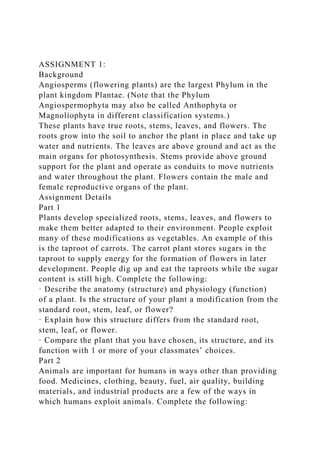
ASSIGNMENT 1BackgroundAngiosperms (flowering plants) are the .docx
- 1. ASSIGNMENT 1: Background Angiosperms (flowering plants) are the largest Phylum in the plant kingdom Plantae. (Note that the Phylum Angiospermophyta may also be called Anthophyta or Magnoliophyta in different classification systems.) These plants have true roots, stems, leaves, and flowers. The roots grow into the soil to anchor the plant in place and take up water and nutrients. The leaves are above ground and act as the main organs for photosynthesis. Stems provide above ground support for the plant and operate as conduits to move nutrients and water throughout the plant. Flowers contain the male and female reproductive organs of the plant. Assignment Details Part 1 Plants develop specialized roots, stems, leaves, and flowers to make them better adapted to their environment. People exploit many of these modifications as vegetables. An example of this is the taproot of carrots. The carrot plant stores sugars in the taproot to supply energy for the formation of flowers in later development. People dig up and eat the taproots while the sugar content is still high. Complete the following: · Describe the anatomy (structure) and physiology (function) of a plant. Is the structure of your plant a modification from the standard root, stem, leaf, or flower? · Explain how this structure differs from the standard root, stem, leaf, or flower. · Compare the plant that you have chosen, its structure, and its function with 1 or more of your classmates’ choices. Part 2 Animals are important for humans in ways other than providing food. Medicines, clothing, beauty, fuel, air quality, building materials, and industrial products are a few of the ways in which humans exploit animals. Complete the following:
- 2. · Choose 1 product or benefit that people get from animals (besides food), describe it, and explain how people benefit. · Which do you think is the most important benefit of animals? Select 1 benefit and explain. · List 3 adaptations that animals have that plants do not have. Provide references in APA format. This includes a reference list and in-text citations for references used throughout the assignment. In your own words, please post a response to the Discussion Board. Be sure to compare and contrast your choice to other plants presented by at least two other students by responding to their posts, using "Reply to Message." You will be graded on the quality of your postings. ASSIGNMENT #2 Student Sheet Name: Date: Instructor’s Name: Assignment: SCIE207 Phase 5 Lab Report Title: Taxonomy Lab to Show Organism Relationships Instructions: You will need to fill out the data table and answer a set of questions.
- 3. When your lab report is complete, submit this document to your instructor in your assignment box. Part 1: Using the lab animation, fill in the following data tables to help you answer the questions that follow: Table 1: Samples 1–5 Phylum/Class Sample 1: Chrysophyta Sample 2: Annelida Sample 3: Arthropoda Sample 4: Amphibia Sample 5: Aves Common Feature Nutrition How does the organism break down and absorb food? Circulatory System (Transport) How does the organism get what it needs to the cells (open, closed, diffusion only)?
- 4. Respiratory System How does the organism get oxygen and release carbon dioxide? Reproductive System Does the organism use asexual or sexual reproduction (eggs, seeds, spores, placenta, and type of fertilization)? Excretory System How does the organism get rid of waste and maintain an ionic balance of fluids? Growth and Development Does the organism go through metamorphosis, develop in an egg or uterus, or grow from seeds? Regulation
- 5. How does the organism control body processes (hormones, nervous system)? Sample Organism Table 2: Samples 6–10 Phylum/Class Sample 6: Reptilia Sample 7: Mammalia Sample 8: Bryophyta Sample 9: Pinophyta Sample 10: Anthrophyta Common Feature Nutrition How does the organism break down and absorb food?
- 6. Circulatory System (Transport) How does the organism get what it needs to the cells (open, closed, diffusion only)? Respiratory System How does the organism get oxygen and release carbon dioxide? Reproductive System Does the organism use asexual or sexual reproduction (eggs, seeds, spores, placenta, and type of fertilization)? Excretory System How does the organism get rid of waste and maintain an ionic balance of fluids? Growth and Development Does the organism go through metamorphosis, develop in an
- 7. egg or uterus, or grow from seeds? Regulation How does the organism control body processes (hormones, nervous system)? Sample Organism Part 2: Using only information from your completed data table, answer the following questions: 1. What is common among organisms from samples 1, 9, and 10? 2. What is common between the circulatory systems of organisms from samples 5, 6, and 7, but is different in organisms from sample 4? 3. What is common in the respiration systems of the organisms
- 8. from samples 2 and 4? 4. What gas is taken in by the respiratory system of organisms from samples 1, 9, and 10? How is it used by these organisms? 5. According to the table, which organisms are producers (autotrophic)? 6. According to the table, which organisms are consumers (heterotrophic)? 7. Which organisms have true blood? Which have a blood-like substance?